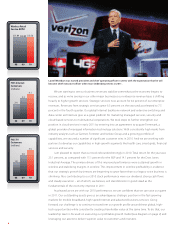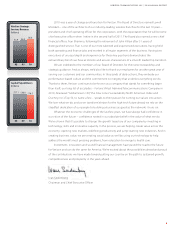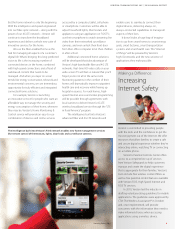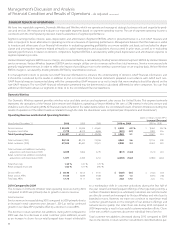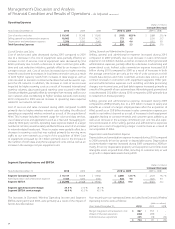Verizon Wireless 2010 Annual Report Download - page 16
Download and view the complete annual report
Please find page 16 of the 2010 Verizon Wireless annual report below. You can navigate through the pages in the report by either clicking on the pages listed below, or by using the keyword search tool below to find specific information within the annual report.
During the second quarter of 2010, as a condition of the regula-
tory approvals by the Department of Justice (DOJ) and the Federal
Communications Commission (FCC) to complete the acquisition of Alltel
Corporation (Alltel) in January 2009, Verizon Wireless divested overlap-
ping properties in 105 operating markets in 24 states (Alltel Divestiture
Markets). The Verizon Wireless customer base was reduced by approxi-
mately 2.1 million customers, after certain adjustments. In July 2010, the
Company spun-off to its stockholders a subsidiary of Verizon (Spinco)
which held defined assets and liabilities of the local exchange business
and related landline activities of Verizon in predominantly rural areas in 14
states. Immediately following the spin-off, Spinco merged with Frontier
Communications Corporation (Frontier) pursuant to a definitive agreement
withFrontier.ThistransactionfurtherfocusedVerizon’sassetbasearound
its fastest growing businesses – wireless, FiOS and other broadband devel-
opmentandglobalIPnetworks.(See“AcquisitionsandDivestitures.”)
Our results of operations, financial position and sources and uses of cash
in the current and future periods reflect our focus on the following stra-
tegic imperatives:
Revenue Growth – To generate revenue growth we are devoting our
resources to higher growth markets, such as the wireless voice and data
markets, the broadband and video markets, and the provision of strategic
services to business markets, rather than to the traditional wireline voice
market. During 2010, consolidated revenue decreased 1.2% compared to
2009 primarily due to the sale of divested operations as well as lower rev-
enue in the Wireline segment resulting from switched access line losses
and decreased minutes of use (MOUs), partially offset by higher revenues
in our growth markets. We continue to develop and market innovative
product bundles to include local, long distance, wireless, broadband data
and video services for consumer, business and government customers.
We anticipate that these efforts will help counter the effects of competi-
tion and technology substitution that have resulted in access line losses,
and enable us to grow consolidated revenues.
Market Share Gains – In our wireless business, our goal is to continue to
be the market leader in providing wireless voice and data communica-
tion services in the United States. As the demand for wireless data services
grows, we continue to increase our data revenues by expanding our pen-
etration of data services as a result of increased sales of smartphone and
other data-capable devices. In 2010, we launched our fourth-generation
(4G) Long-Term Evolution technology (LTE) network in 38 major metro-
politan areas and more than 60 commercial airports in the United States.
We expect to deploy 4G LTE in an additional 140 markets by the end of
2011 and in virtually our entire current 3G network footprint by the end
of 2013. In our wireline business, our goal is to become the leading pro-
vider of communications products and services in each of the markets
in which we operate. We are focused on providing the highest network
reliability and innovative products and services. During 2010, we invested
$16.5 billion in capital expenditures.
In Domestic Wireless:
• asofDecember31,2010comparedto2009,totalcustomersincreased
5.6% to 94.1 million; and
• during 2010comparedto2009, totaldataaveragerevenuepercus-
tomerpermonth(ARPU)increasedby17.3%to$17.73.
During 2010, in Wireline:
• we added 232,000 net wireline broadband connections, including
796,000 net new FiOS Internet subscribers, for a total of 8.4 million
connections, including 4.1 million FiOS Internet subscribers;
• weadded722,000netnewFiOSTVsubscribers,foratotalof3.5million
FiOS TV subscribers; and
• totalbroadbandandvideorevenueswereapproximately$6.8billion.
MANAGEMENT’S DISCUSSION AND ANALYSIS OF FINANCIAL
CONDITION AND RESULTS OF OPERATIONS AS ADJUSTED
During the fourth quarter of 2010, Verizon retrospectively changed its method
of accounting for benefit plans as described in Note 1 to the consolidated
financial statements. As a result, all prior periods have been adjusted. As part
of this change to our method of accounting, the service cost and the amor-
tization of prior service costs, which are representative of the benefits earned
by active employees during the period, will continue to be allocated to the
segment in which the employee is employed, while interest cost and expected
return on assets will now be recorded at the Corporate level. The recognition
of actuarial gains and losses will also be recorded at the Corporate level.
In addition, in order to comply with regulatory conditions related to the acqui-
sition of Alltel in January 2009, Verizon Wireless divested certain overlapping
properties during the first half of 2010. On July 1, 2010, certain of Verizon’s
local exchange business and related landline activities were spun off. During
the second quarter of 2010, we recorded a non-cash adjustment primarily to
adjust wireless data revenues.
Accordingly, Domestic Wireless and Wireline results from these operations as
well as the deferred revenue adjustment have been reclassified to Corporate
and Other to reflect comparable segment operating results consistent with
the information regularly reviewed by our chief operating decision maker.
We have adjusted prior-period consolidated and segment information, where
applicable, to conform to current year presentation.
OVERVIEW
Verizon Communications Inc. (Verizon, or the Company), is one of the
world’s leading providers of communications services. Our domestic
wireless business, operating as Verizon Wireless, provides wireless voice
and data products and services across the United States using one of
the most extensive and reliable wireless networks. Our wireline business
provides communications products and services, including voice, broad-
band data and video services, network access, long distance and other
communications products and services, and also owns and operates one
of the most expansive end-to-end global Internet Protocol (IP) networks.
We have a highly diverse workforce of approximately 194,400 employees
as of December 31, 2010.
In the sections that follow, we provide information about the important
aspects of our operations and investments, both at the consolidated and
segment levels, and discuss our results of operations, financial position
and sources and uses of cash. In addition, we highlight key trends and
uncertainties to the extent practicable. We also monitor several key eco-
nomic indicators, as well as the state of the economy in general, primarily
in the United States, where the majority of our operations are located for
purposes of evaluating our operating results and assessing the potential
impacts of these factors on our businesses. While most key economic
indicators, including gross domestic product, affect our operations to
some degree, we historically have noted higher correlations to non-farm
employment, personal consumption expenditures and capital spending,
as well as more general economic indicators such as inflationary or reces-
sionary trends and housing starts.
During 2010, we faced the challenges posed by a global economic
downturn and continued to increase revenues in our growth businesses,
increase free cash flow, and make strategic investments in wireless, broad-
band, global connectivity and video. At the same time, we took significant
actions to improve our cost structure, in part by reaching agreements
with certain unions on temporary enhancements and addressing future
profitability as described below.
14
Management’sDiscussionandAnalysis
ofFinancialConditionandResultsofOperations – As Adjusted
VERIZON COMMUNICATIONS INC. AND SUBSIDIARIES


